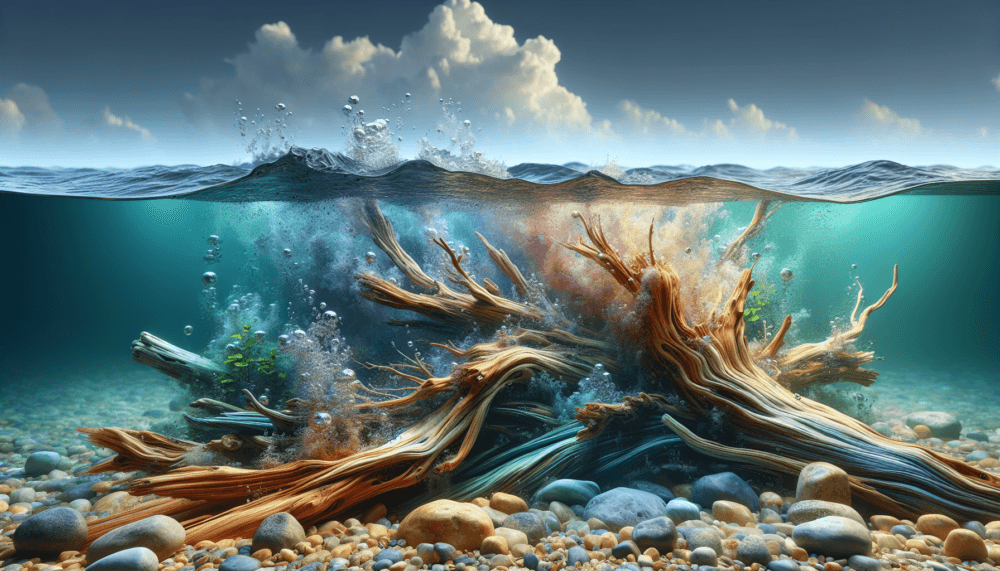Imagine you’re strolling along a picturesque beach, mesmerized by the rhythmic crashing of waves against the shore. Your eyes catch a glimpse of a beautifully weathered piece of driftwood nestled among the sand. As you bend down to inspect it, curiosity floods your mind – do these remnants of trees have the ability to stain the crystal-clear water surrounding you? It’s a question that has piqued the interest of many beachcombers and nature enthusiasts alike. In this article, we will explore the fascinating phenomenon of whether or not driftwood can leave its mark on water, unraveling the secrets hidden beneath its captivating exterior.

What is driftwood?
Definition
Driftwood refers to wood that has been washed up onto shorelines or riverbanks by the tides or currents. It typically originates from trees or branches that have fallen into bodies of water and have been carried by the water currents until they eventually get stranded on land.
Types of driftwood
Driftwood can come in a variety of shapes, sizes, and types. It can be found in freshwater bodies such as rivers and lakes, as well as in saltwater environments like oceans and seas. The type of wood can vary depending on the geographical location and the tree species prevalent in the area. Common types of driftwood include pine, oak, cedar, and birch.
Why does driftwood stain water?
Chemical composition of driftwood
Driftwood contains tannins, which are natural compounds found in wood. These tannins are released into the water when the wood is submerged. Tannins are known to have a yellowish or brownish color, and they can stain the water, giving it a tea-like appearance.
Leaching process
When driftwood is submerged in water, the tannins within the wood start to leach out. The leaching process occurs when the tannins dissolve in the water, creating a colored solution. This solution can then spread throughout the aquarium, discoloring the water.
Effects of water temperature
The temperature of the water can affect the leaching process of tannins from driftwood. Higher temperatures tend to accelerate the leaching process, resulting in more significant staining of the water. Conversely, lower temperatures can slow down the leaching process, potentially reducing the intensity of the staining.
Effects of water pH
The pH level of the water can also influence the degree of staining caused by driftwood. Acidic water, with a lower pH, tends to enhance the release of tannins and intensify the staining effect. On the other hand, alkaline water, with a higher pH, may inhibit the leaching of tannins and minimize staining.
The factors affecting water staining
Size and age of driftwood
The size and age of driftwood can impact the amount of staining it causes. Larger pieces of driftwood generally contain more tannins, which can result in a more significant staining effect. Older driftwood that has been submerged for an extended period is more likely to have released a significant amount of tannins, increasing the potential for water staining.
Density of driftwood
The density of driftwood can also play a role in the extent of water staining. Wood with a higher density tends to contain more tannins, leading to a more notable staining effect. Softer and less dense driftwood may release fewer tannins and result in less staining.
Exposure to sunlight
Exposure to sunlight can affect the leaching of tannins from driftwood. Sunlight can accelerate the breakdown of organic compounds, including tannins, and promote their release into the water. If the aquarium or the driftwood is exposed to direct sunlight, it may lead to increased staining.
Water flow
The water flow within the aquarium can influence the distribution of tannins and the extent of water staining. Stronger water currents can help disperse the tannins throughout the tank, resulting in more evenly distributed staining. In contrast, weak water flow may cause the tannins to accumulate in specific areas, leading to localized staining.
Impact of driftwood stains
Visual appearance
One of the most apparent impacts of driftwood staining is the effect it has on the visual appearance of the aquarium. The discoloration of the water can make it look murky or yellowish, which may detract from the overall aesthetics of the tank. Some aquarium enthusiasts prefer clear water, and the staining caused by driftwood may be considered undesirable.
Impact on aquatic life
Driftwood staining does not have any direct harmful effects on fish or other aquatic life. In fact, some fish species, such as those native to blackwater environments, may benefit from the presence of tannins in the water. These compounds can mimic the natural habitat conditions of certain fish, creating an environment that promotes their well-being and natural behaviors.
Water quality issues
While driftwood staining may not pose any direct harm to aquatic life, it can affect water quality in some cases. The tannins released by driftwood can lower the pH of the water, making it more acidic. This change in pH can potentially impact the health and well-being of certain fish species that prefer neutral or alkaline water conditions. Additionally, excessive staining can indicate a buildup of organic compounds, which may lead to poor water quality if not properly addressed.

Methods to prevent driftwood staining
Pre-soaking driftwood
One effective method to minimize driftwood staining is to pre-soak the wood before placing it in the aquarium. By soaking the wood in a separate container with clean water, the tannins can be partially leached out beforehand. This process can help reduce the initial intensity of the staining when the driftwood is introduced into the aquarium.
Boiling driftwood
Boiling driftwood is another commonly used method to remove tannins and minimize staining. By boiling the wood for an extended period, the tannins are leached out more quickly and efficiently. This process effectively reduces the likelihood of significant staining once the driftwood is placed in the aquarium.
Chemical treatment
Chemical treatments can also be used to prevent or reduce driftwood staining. Water conditioners or special additives designed to remove or neutralize tannins can be added to the aquarium. These products can bind to the tannins and prevent them from leaching into the water, effectively minimizing staining.
Regular maintenance
Regular maintenance practices, such as water changes and thorough cleaning of the aquarium, can help manage driftwood staining. By regularly removing a portion of the water and replacing it with fresh, clean water, the tannins can be diluted and their concentration reduced. Additionally, cleaning the driftwood itself can remove any loose tannins and minimize staining.
The benefits of driftwood in aquariums
Aquatic habitat enrichment
Driftwood can provide numerous benefits for the inhabitants of an aquarium. It can serve as a natural habitat for fish and other aquatic organisms, mimicking the structure and complexity of their native environments. Driftwood can provide hiding places, shelter, and breeding areas, enhancing the overall well-being and natural behaviors of the aquarium inhabitants.
Natural aesthetic appeal
Despite the staining potential, driftwood can contribute to the natural aesthetic appeal of an aquarium. It adds a natural and rustic element to the tank, creating a visually appealing environment. The interesting shapes, textures, and colors of driftwood can complement the plants, fish, and overall theme of the aquarium, creating a more visually captivating display.
Biological filtration
Driftwood can also have a positive impact on the biological filtration of the aquarium. The porous nature of wood provides a habitat for beneficial bacteria, which play a crucial role in breaking down harmful substances such as ammonia and nitrites. These bacteria help maintain a healthy and stable ecosystem within the aquarium, promoting the well-being of the fish and other aquatic inhabitants.
How to remove driftwood stains
Water changes
Performing regular water changes is one of the most effective methods to remove driftwood stains. By replacing a portion of the stained water with fresh, clean water, the concentration of tannins is diluted, gradually reducing the intensity of the staining. Consistent and frequent water changes can help maintain clear water in the aquarium over time.
Filtration systems
Utilizing appropriate filtration systems can aid in removing driftwood stains. Mechanical or chemical filtration media can help trap and remove tannins from the water, effectively reducing water discoloration. Activated carbon, for example, can be placed in the aquarium filter to absorb and remove tannins, helping to restore clear water.
Chemical treatments
Certain chemical treatments, specifically designed to remove tannins, can be used to effectively eliminate driftwood stains. These treatments often contain substances that bind to tannins and precipitate them out of the water, allowing for easier removal. Following the instructions provided by the product manufacturer is essential to ensure safe and effective use.
Common misconceptions about driftwood stains
Driftwood causing water discoloration
One common misconception is that driftwood itself is responsible for water discoloration. However, it is the tannins within the wood that cause the staining. Not all types of driftwood release the same amount of tannins, which means some may cause more staining than others. It’s important to understand that it is the leaching process and the chemical composition of the wood that contribute to water discoloration, rather than the driftwood itself.
Harmful effects on fish
Another misconception is that driftwood staining is harmful to fish. While it may be aesthetically undesirable for some aquarium owners, the staining itself does not pose any direct harm to fish or other aquatic organisms. In fact, as mentioned earlier, certain fish species may even benefit from the presence of tannins, as it replicates their natural habitat conditions.
Invariable staining of water
Some people mistakenly believe that driftwood stains water indefinitely. However, with the appropriate preventive measures and regular maintenance, the intensity of the staining can be reduced and eventually eliminated. By employing techniques such as pre-soaking, boiling, chemical treatment, and regular water changes, the staining effects of driftwood can be effectively managed.
Alternative decor options for aquariums
Plastic or resin decorations
For those who prefer to avoid driftwood staining altogether, plastic or resin decorations are a viable alternative. These decorations come in various shapes, sizes, and designs, offering a wide range of options to suit individual preferences. Plastic and resin decorations do not release any tannins into the water, ensuring a consistently clear and unstained aquarium.
Ceramic ornaments
Ceramic ornaments provide another excellent alternative to driftwood. They are typically made from non-porous materials, meaning they will not release any substances into the water. Ceramic ornaments come in a variety of styles and designs, allowing for creative and attractive setups without the worry of staining.
Live plants
Live plants can be a natural and vibrant alternative to driftwood. They not only add beauty and visual interest to the aquarium but also contribute to the overall health and well-being of the aquatic environment. Live plants absorb nutrients from the water, helping to maintain water quality and reducing the chances of staining.
Conclusion
Driftwood can add a unique and natural touch to aquariums, but it can also cause water staining due to the tannins it releases. Understanding the factors that contribute to driftwood staining, such as the chemical composition, water temperature, pH, and water flow, is essential in managing and minimizing the staining effects. Various methods, such as pre-soaking, boiling, chemical treatments, and regular maintenance, can be used to prevent and remove driftwood stains. Despite the potential for staining, driftwood offers numerous benefits to aquariums, including habitat enrichment, aesthetic appeal, and biological filtration. However, for those who prefer alternatives, plastic or resin decorations, ceramic ornaments, and live plants can provide a stain-free and visually appealing option. By considering these factors and options, aquarium enthusiasts can create a beautiful and balanced aquatic environment.